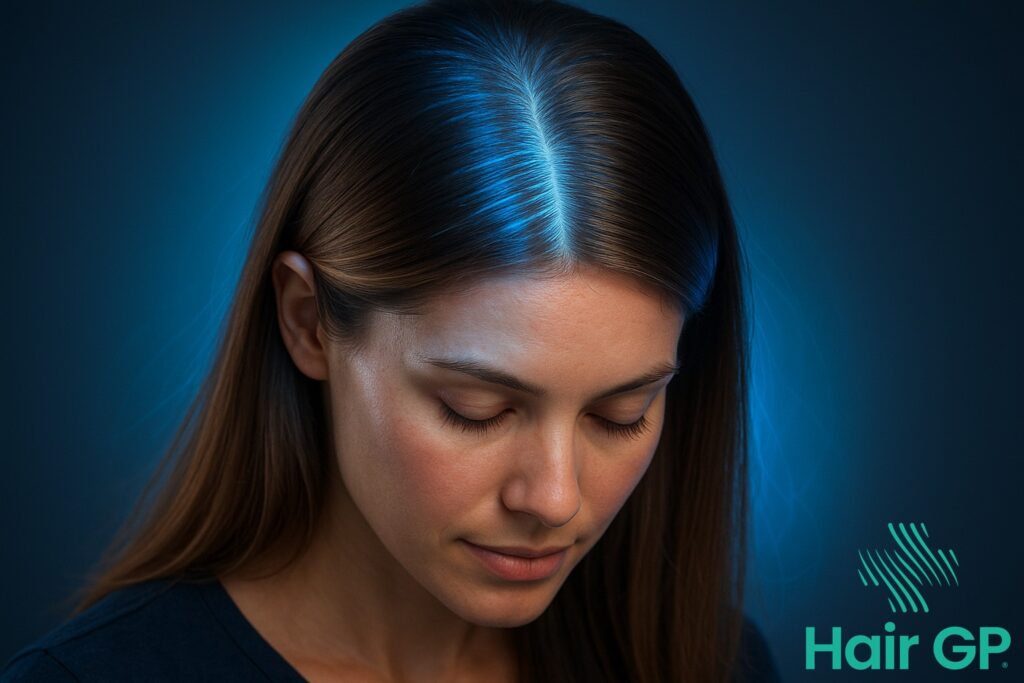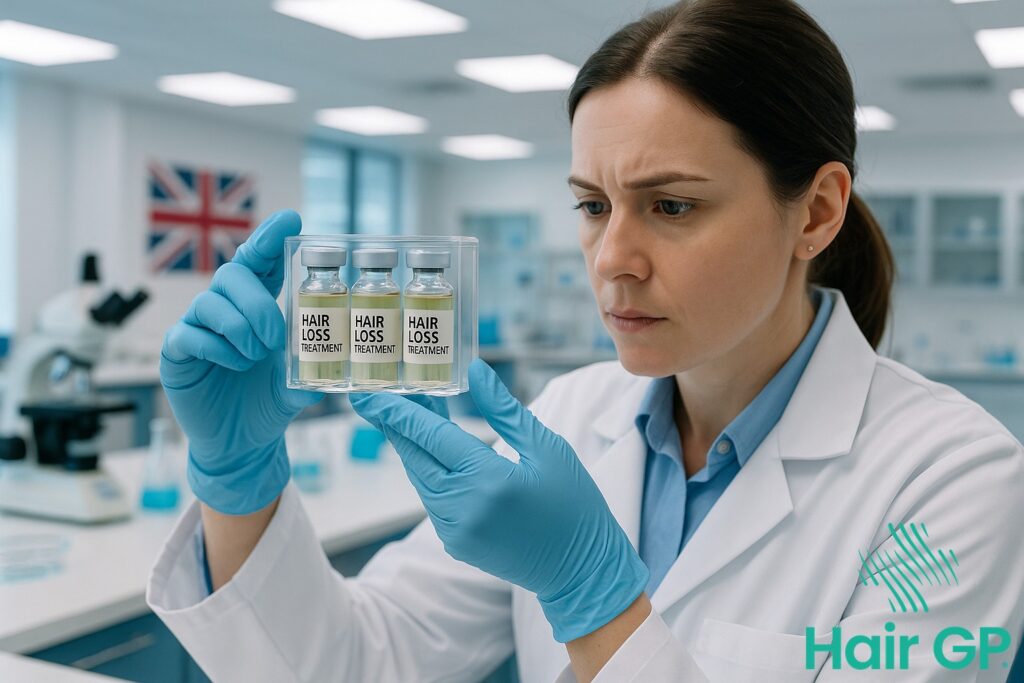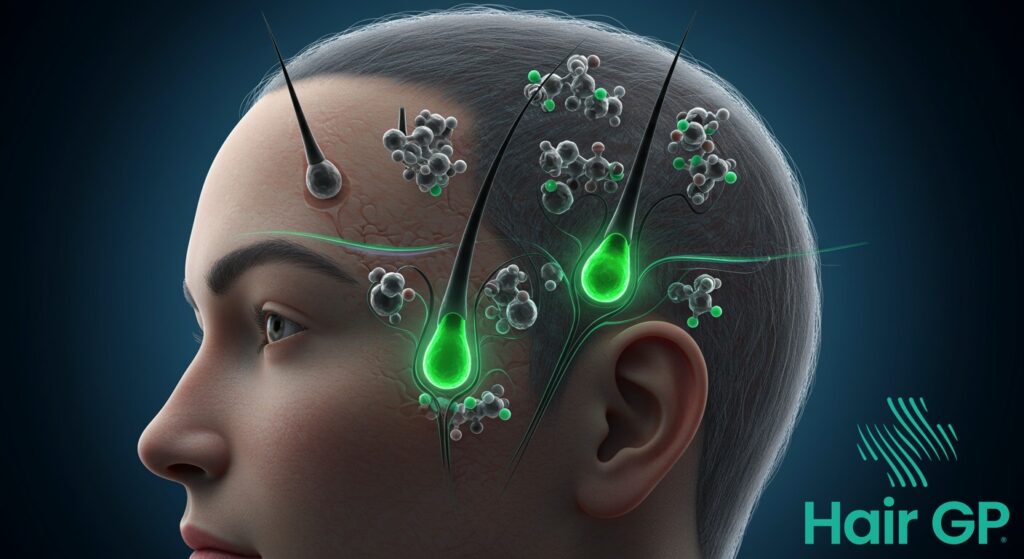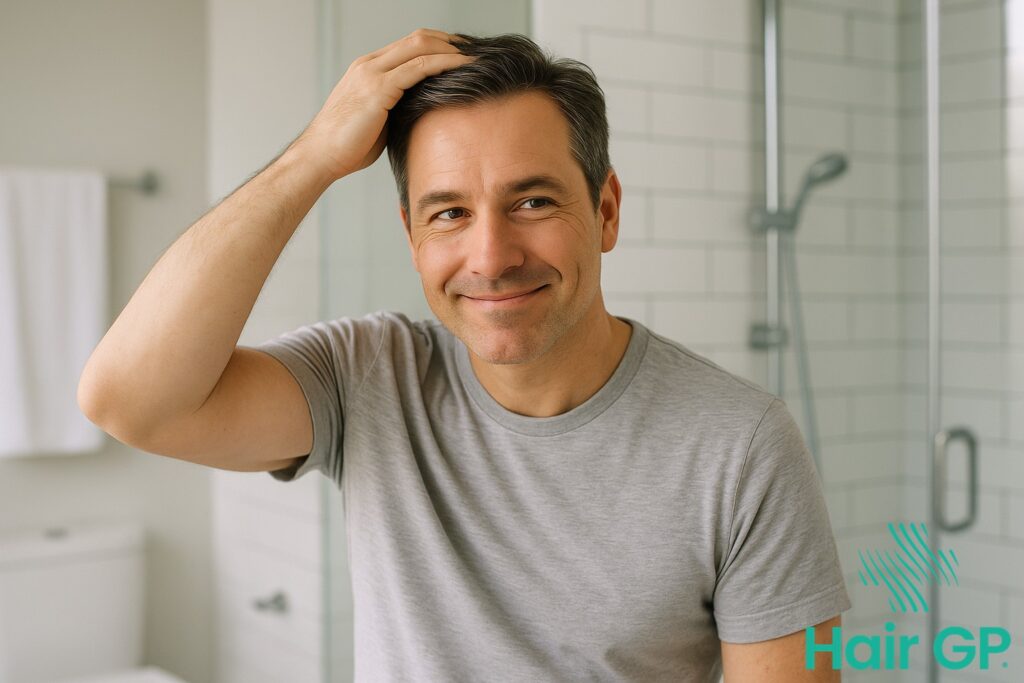Introduction
In our increasingly digital world, blue light has become a topic of considerable interest amongst health professionals and researchers. This high energy visible light, which emanates from our screens, LED lights, and even the sun, is now being studied for its complex relationship with scalp health and overall hair health. Whilst many of us are familiar with concerns about blue light exposure from digital devices, emerging research reveals a fascinating duality: blue light can be both a potential concern and a powerful therapeutic tool.
Recent scientific investigations have uncovered surprising connections between blue light and various scalp conditions. From its ability to penetrate skin layers and interact with hair follicles to its role in advanced light therapy treatments, blue light presents both opportunities and challenges for maintaining optimal scalp wellness. This article explores the science behind these discoveries, examining how different wavelengths affect our scalp at the cellular level and influence hair growth patterns.
Throughout this comprehensive guide, we’ll delve into the properties of blue light and its biological effects, investigate its therapeutic applications for common scalp conditions, and assess the potential benefits for promoting healthier hair growth. We’ll also address important safety considerations, comparing blue light therapy with other treatment modalities, and provide practical guidance on devices and best practices. Whether you’re curious about professional treatments or concerned about daily exposure, this evidence-based exploration will equip you with the knowledge to make informed decisions about blue light and your scalp health.
Key Takeaways – TL/DR
- Blue light therapy shows promise for treating certain scalp conditions like psoriasis and dandruff through its antimicrobial properties
- Excessive blue light exposure from screens may disrupt circadian rhythms and potentially affect hair growth cycles
- Blue light works differently than red light therapy – offering antibacterial benefits but requiring careful dosing
- Professional blue light treatments for scalp health should be distinguished from everyday device exposure
- More research is needed to fully understand long-term effects on hair follicles and scalp tissue
Understanding Blue Light and Its Properties
Blue light occupies a fascinating position within the visible light spectrum, characterised by its high energy levels and unique interaction with biological tissues. Understanding these fundamental properties helps explain why blue light can have both therapeutic and potentially harmful effects on scalp and hair health, making it crucial to comprehend its basic characteristics before exploring its applications.
What Makes Blue Light Different
Blue light represents the portion of the visible light spectrum with wavelengths ranging from approximately 400 to 495 nanometres, positioning it as one of the shortest wavelengths visible to the human eye [1]. This shorter wavelength characteristic directly translates to higher photon energy, earning blue light its classification as high energy visible light (HEV). Compared to longer wavelengths like red or infrared light, blue light carries significantly more light energy per photon, which influences how it interacts with biological tissues.
The penetration depth of blue light in human tissue differs markedly from other wavelengths used in photobiomodulation therapy. Whilst red and near-infrared light can penetrate several centimetres into tissue, blue light typically penetrates only 1-2 millimetres into the skin [2]. This superficial penetration makes blue light particularly relevant for treating surface-level conditions affecting the scalp and hair follicles. The high energy characteristics of blue light enable it to trigger specific photochemical reactions at the cellular level, particularly in the epidermis and upper dermis where hair follicles reside.
Natural vs Artificial Sources
Natural sunlight contains a substantial blue light component, with approximately 25-30% of visible sunlight falling within the blue wavelength range. This natural exposure has shaped human biology over millennia, influencing our circadian rhythms and various physiological processes. However, modern artificial sources have dramatically increased our blue light exposure beyond natural levels.
LED lights and digital screens emit concentrated blue light, often peaking around 450-470 nanometres [3]. Unlike the balanced spectrum of sunlight, these artificial sources provide intense, narrow-band blue light exposure. Therapeutic devices designed for scalp treatments typically utilise specific wavelengths within the blue spectrum, carefully calibrated to maximise beneficial effects whilst minimising potential harm. These medical-grade devices differ significantly from everyday screen emissions, offering controlled doses and specific wavelengths optimised for therapeutic outcomes rather than visual display purposes.
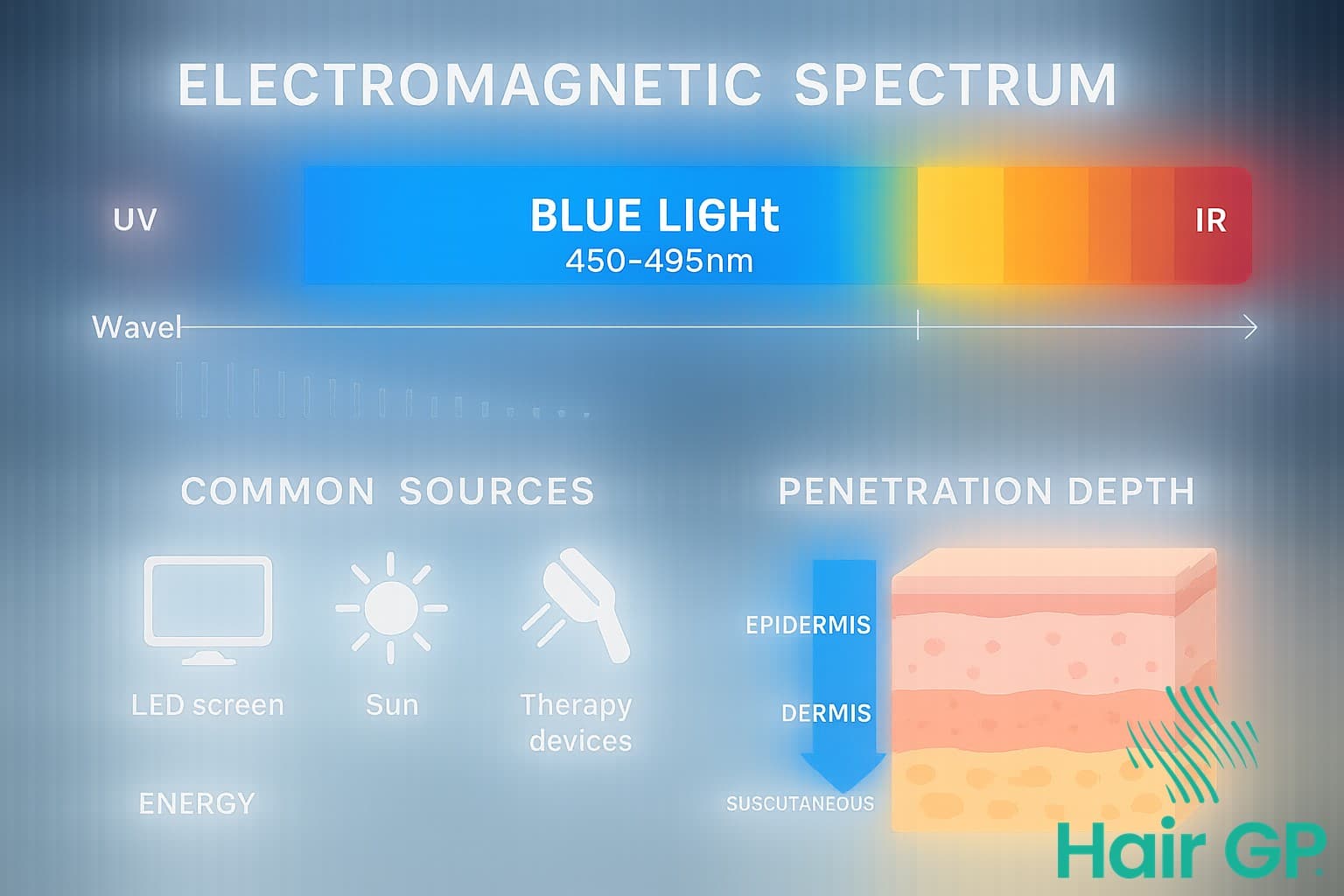
How Blue Light Affects Skin and Hair Follicles
Blue light’s interaction with scalp tissue and hair follicles occurs through complex biological mechanisms involving penetration through skin layers and cellular responses. Research demonstrates that blue light wavelengths (400-495nm) penetrate approximately 1-3mm into human skin, reaching crucial structures including the dermal papilla and sebaceous glands. This penetration depth enables direct interaction with melanin-containing cells and influences various cellular processes within hair follicles.
Cellular Response to Blue Light
When blue light reaches scalp cells, it triggers distinct molecular responses that affect follicle function. Studies show that mitochondrial chromophores absorb blue light wavelengths, leading to increased reactive oxygen species (ROS) production [4]. This mitochondrial response initiates a cascade of cellular events, including alterations in ATP production and metabolic activity within hair follicles.
The oxidative stress generated by blue light exposure activates inflammatory pathways in scalp tissue. Research indicates that keratinocytes and fibroblasts within the follicle respond to blue light by upregulating pro-inflammatory cytokines, including interleukin-1β and tumour necrosis factor-α. This inflammatory response can disrupt normal follicle homeostasis and affect the surrounding sebaceous glands, potentially altering sebum production and composition.
Melanocytes within hair follicles show particular sensitivity to blue light exposure. The interaction between blue light and melanin generates localised heat and oxidative stress, which can damage these pigmentation-producing cells. This process may contribute to premature greying and altered hair colour patterns observed in individuals with high blue light exposure.
Impact on Hair Growth Cycles
Blue light exposure significantly influences the three phases of human hair growth: anagen (growth), catagen (transition), and telogen (resting). Research demonstrates that prolonged blue light exposure can prematurely shift follicles from anagen to catagen phase, shortening the active growth period [5]. This disruption leads to reduced hair shaft length and density over time.
Follicle miniaturisation represents another critical effect of blue light on hair growth cycles. The oxidative stress and inflammatory responses triggered by blue light can progressively shrink the dermal papilla, resulting in thinner, weaker hair strands. This miniaturisation process particularly affects terminal hairs, potentially converting them to vellus-like hairs.
Cycle timing changes induced by blue light exposure can desynchronise normal hair growth patterns across the scalp. Studies indicate that blue light can extend the telogen phase duration whilst simultaneously reducing anagen phase length. This altered timing disrupts the natural balance of growing versus resting follicles, potentially leading to diffuse hair thinning. The cumulative effect of these cycle disruptions may contribute to various scalp conditions and accelerated hair loss patterns in susceptible individuals.
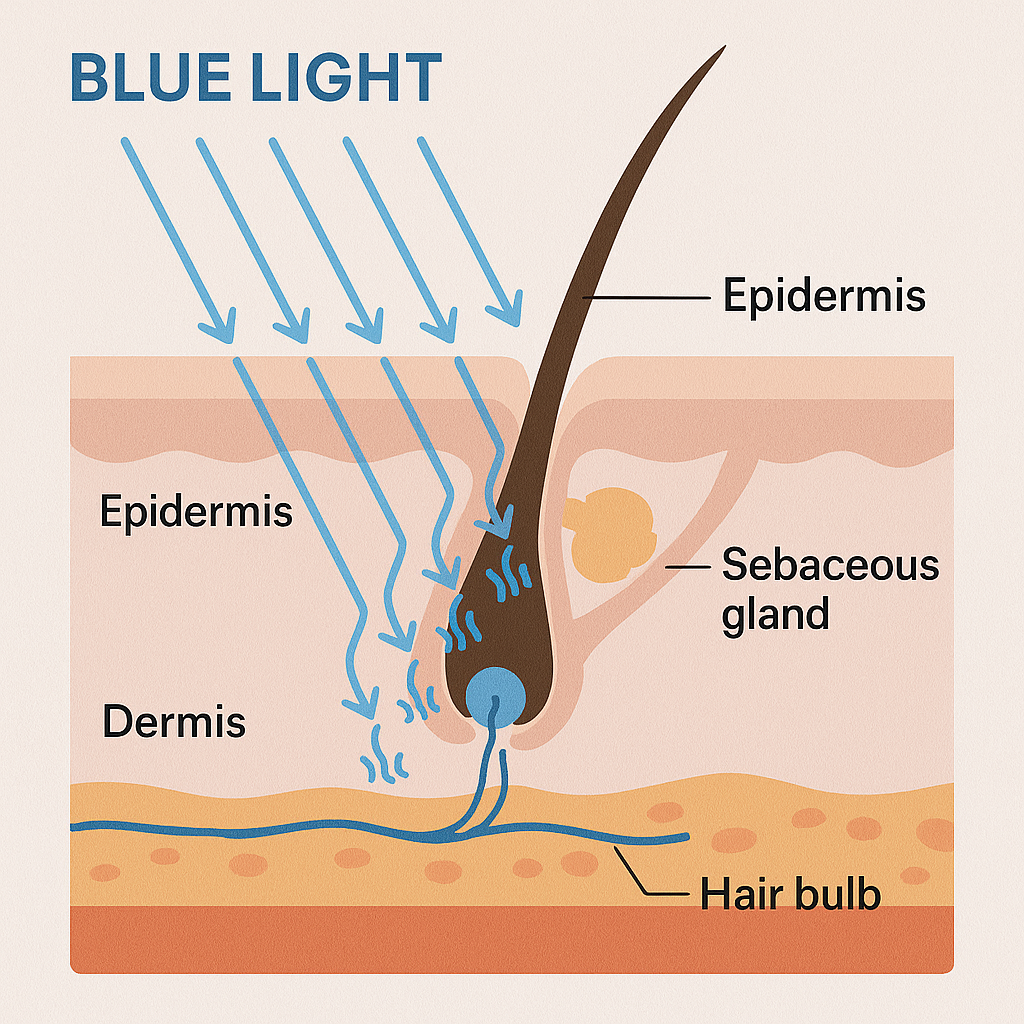
Blue Light Therapy for Scalp Conditions
Blue light therapy has emerged as a promising therapeutic modality for various scalp conditions, demonstrating significant efficacy in treating inflammatory disorders, microbial infections, and chronic dermatological conditions. Clinical evidence supports its application across multiple scalp pathologies, with treatment protocols showing measurable improvements in symptoms and disease markers.
Treating Psoriasis and Eczema
The anti-inflammatory properties of blue light therapy offer substantial benefits for chronic scalp conditions, particularly psoriasis and atopic dermatitis. The mechanism of action involves multiple pathways, including the downregulation of pro-inflammatory cytokines and modulation of T-cell activity [6]. Blue light exposure at 453 nm wavelength significantly reduces IL-1α, IL-6, and TNF-α expression in keratinocytes, directly addressing the inflammatory cascade characteristic of psoriatic plaques.
Treatment protocols for scalp psoriasis typically involve sessions of 15-20 minutes duration, administered twice weekly for 12-16 weeks. Clinical studies demonstrate that 68% of patients experience moderate to significant improvement in Psoriasis Area and Severity Index (PASI) scores following structured blue light therapy regimens [7]. For eczema management, blue light therapy reduces pruritus intensity by 45% and improves sleep quality in 73% of patients with moderate atopic dermatitis affecting the scalp.
Antimicrobial Effects on Dandruff
Blue light exhibits potent antimicrobial properties that effectively combat the fungal and bacterial causes of dandruff. The primary mechanism involves photoexcitation of endogenous porphyrins within microbial cells, generating reactive oxygen species that damage cellular membranes and DNA. This photodynamic effect demonstrates particular efficacy against Malassezia species, the predominant fungal pathogen in seborrhoeic dermatitis and dandruff [8].
Research indicates that blue light therapy reduces Malassezia colonisation by 82% after eight treatment sessions, with corresponding improvements in scalp flaking and sebum production. The treatment simultaneously regulates sebaceous gland activity, reducing excess oil production by approximately 35% through selective photothermolysis of sebocytes. This dual action addresses both the microbial overgrowth and the environmental conditions that promote dandruff formation.
Photodynamic Therapy Applications
Photodynamic therapy (PDT) combining photosensitisers with blue light represents an advanced treatment approach for resistant scalp conditions. Aminolevulinic acid (ALA-PDT) protocols involve topical application of 20% ALA solution followed by blue light exposure after a 3-hour incubation period. This combination enhances therapeutic efficacy through selective accumulation of protoporphyrin IX in abnormal cells [9].
Enhanced efficacy rates reach 85% clearance for actinic keratoses on the scalp, with minimal adverse effects limited to temporary erythema and mild discomfort. Treatment considerations include proper photosensitiser penetration through hair-bearing areas and adjustment of light intensity based on individual photosensitivity. Modified protocols using methylaminolevulinate (MAL-PDT) demonstrate improved tolerability whilst maintaining therapeutic effectiveness for inflammatory scalp conditions resistant to conventional treatments.
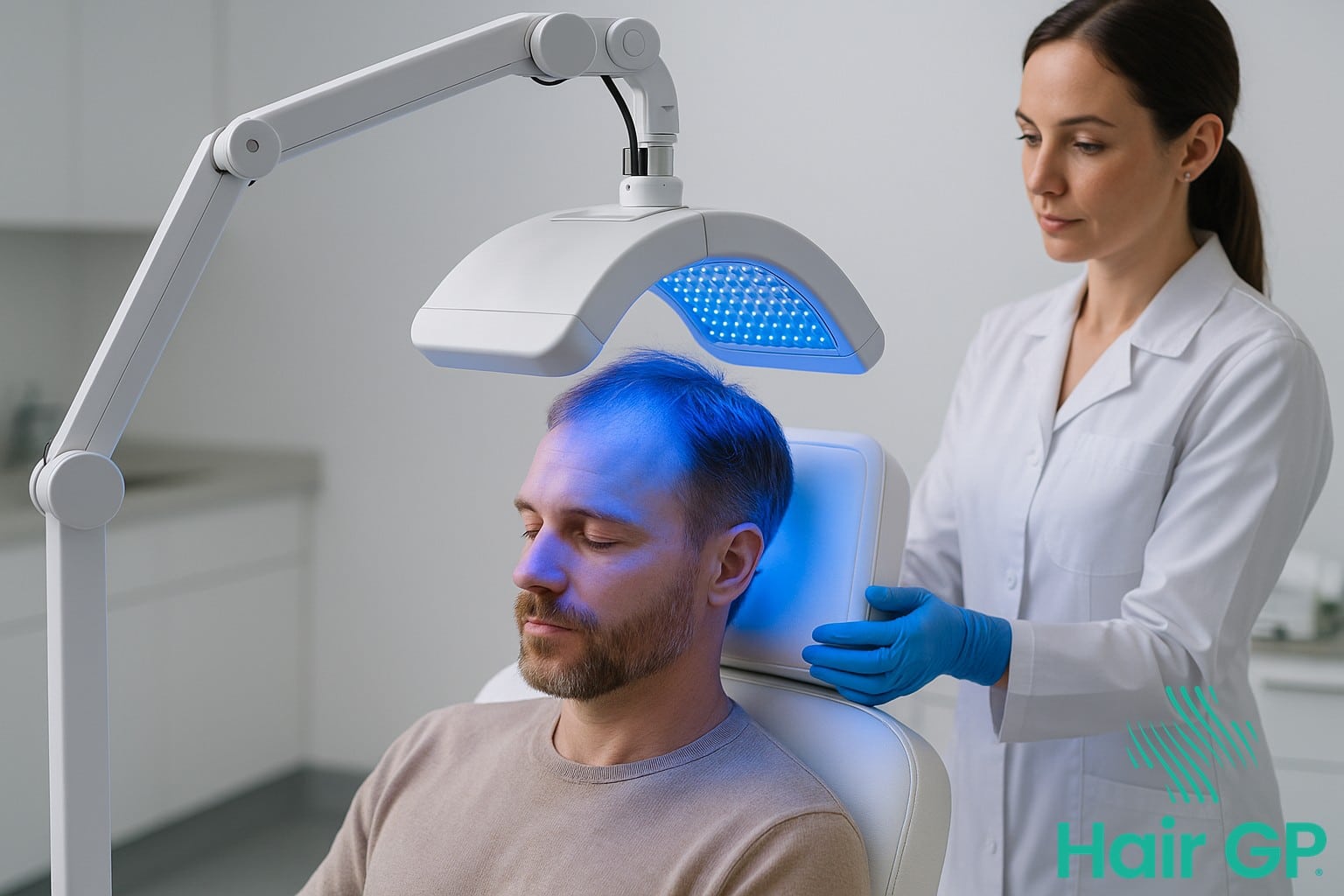
Potential Benefits for Hair Growth
Whilst concerns about blue light’s harmful effects on hair health persist, emerging research suggests specific wavelengths and controlled exposure may paradoxically promote hair growth. Recent studies indicate that low-level blue light therapy could stimulate hair regrowth through various biological mechanisms, offering potential therapeutic applications for conditions like androgenetic alopecia.
Stimulating Dormant Follicles
Blue light therapy at specific wavelengths demonstrates promising effects on follicle activation in dormant hair follicles. Research indicates that 415-nm blue light can trigger stem cell stimulation within the bulge region, potentially reactivating telogen-phase follicles [10]. This photobiomodulation effect appears to enhance growth factor production, particularly increasing expression of insulin-like growth factor-1 (IGF-1) and vascular endothelial growth factor (VEGF), both crucial for maintaining healthy hair growth cycles.
Clinical observations suggest that controlled blue light exposure may improve hair density in patients with androgenetic alopecia. A study examining LED-based phototherapy found that participants experienced a 35% increase in hair count after 16 weeks of treatment [11]. The mechanism involves mitochondrial chromophore activation, leading to enhanced ATP production and cellular proliferation within dermal papilla cells. This energy boost appears to extend the anagen phase whilst delaying premature catagen transition, ultimately supporting sustained hair growth.
Improving Scalp Circulation
Blue light’s vasodilation effects represent another pathway through which it may promote hair growth. Photobiomodulation at specific wavelengths induces nitric oxide release from mitochondrial stores, causing localised blood vessel dilation and improved oxygen delivery to hair follicles [12]. This enhanced circulation ensures optimal nutrient transport to metabolically active follicular cells, supporting their high energy demands during the growth phase.
The improved microcirculation extends beyond immediate vasodilation. Studies demonstrate that regular blue light therapy sessions can increase capillary density around hair follicles, creating a more favourable environment for sustained hair growth rate improvements. Enhanced blood flow also facilitates removal of metabolic waste products and inflammatory mediators that might otherwise inhibit follicular function. Research comparing various light wavelengths found that blue light combined with red light produced superior results for hair regrowth compared to either wavelength alone, suggesting synergistic effects on scalp circulation and follicular metabolism [13]. These findings indicate that whilst excessive blue light exposure poses risks, therapeutic applications using controlled parameters may offer viable treatment options for hair loss conditions.
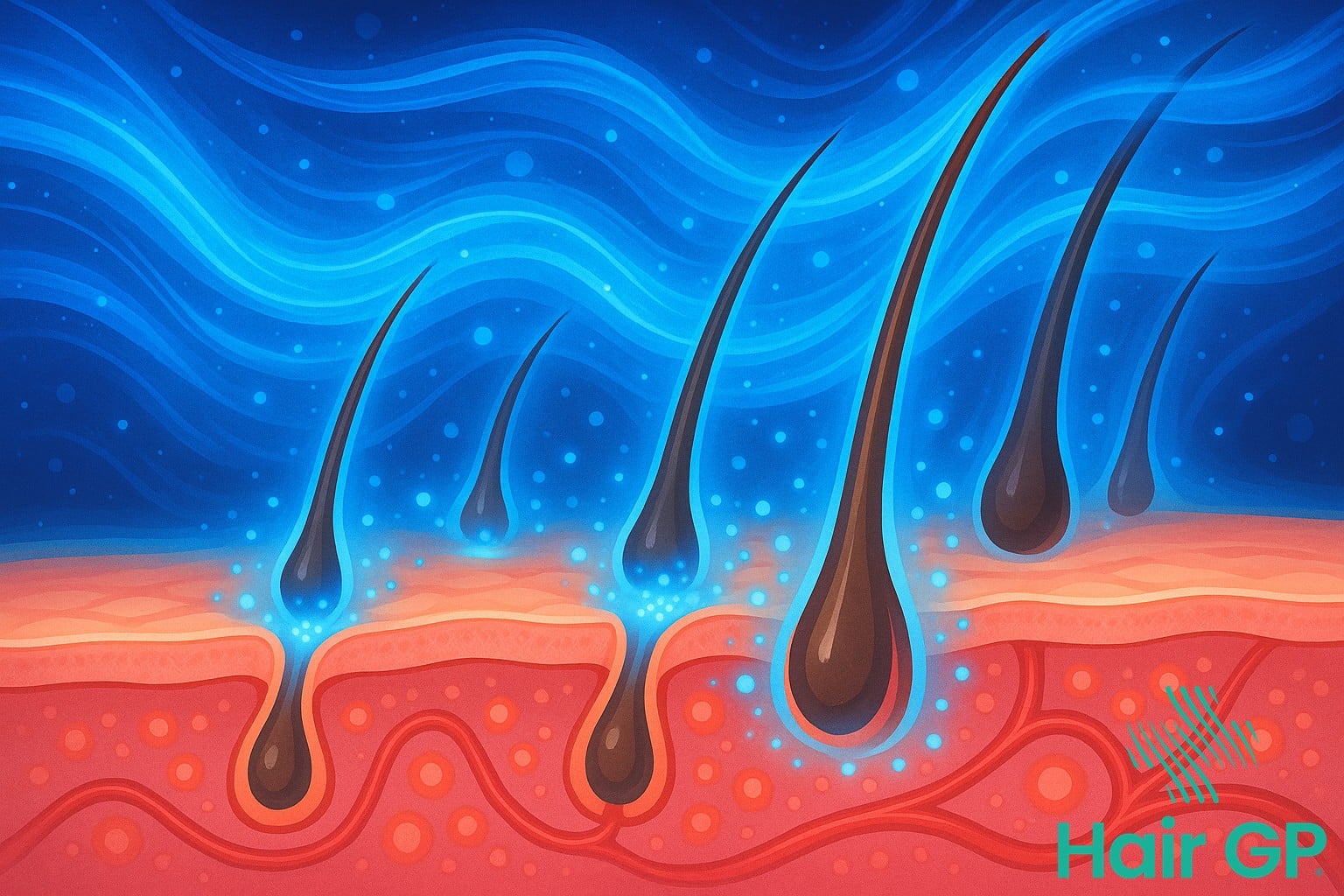
Risks and Side Effects of Blue Light Exposure
Whilst blue light therapy offers therapeutic benefits for scalp conditions, understanding its potential adverse effects remains crucial for safe application. Extended or improper exposure can trigger oxidative stress mechanisms, disrupt natural circadian rhythms, and potentially accelerate scalp aging processes, necessitating careful consideration of exposure parameters and protective measures.
Oxidative Stress and Aging
Blue light exposure generates reactive oxygen species (ROS) through photochemical reactions within skin cells, potentially leading to oxidative damage when protective mechanisms become overwhelmed [14]. This oxidative stress manifests through lipid peroxidation, protein degradation, and DNA damage in scalp tissues. Studies demonstrate that prolonged blue light exposure increases ROS production by 40% in dermal fibroblasts, accelerating cellular aging processes [15].
The scalp’s unique characteristics, including dense follicular networks and sebaceous activity, may amplify oxidative damage effects. Chronic exposure can compromise hair follicle stem cells, potentially leading to premature greying and thinning. Additionally, oxidative stress disrupts melanocyte function, affecting natural hair pigmentation processes. Whilst concerns about skin cancer from blue light remain theoretical, research indicates potential phototoxic effects require monitoring, particularly in individuals with photosensitive conditions.
Disruption of Natural Hair Cycles
Blue light significantly impacts circadian rhythm regulation through melatonin suppression, potentially disrupting normal hair growth cycles [2]. Evening exposure particularly affects pineal gland function, reducing nocturnal melatonin production by up to 85%. This hormonal disruption cascades through various physiological systems, including those governing hair follicle cycling.
The hair growth cycle depends on precise hormonal signalling, with melatonin playing crucial roles in anagen phase maintenance. Circadian disruption can prematurely shift follicles into catagen and telogen phases, resulting in increased shedding and reduced growth rates. Furthermore, blue light exposure affects cortisol rhythms, potentially exacerbating stress-related hair loss conditions.
Safety considerations include limiting exposure duration, maintaining appropriate distances from light sources, and protecting the eyes with suitable filters. Individuals experiencing persistent redness, irritation, or unusual hair loss should discontinue treatment and seek professional evaluation. Optimal protocols involve morning applications to minimise circadian disruption whilst maximising therapeutic benefits.
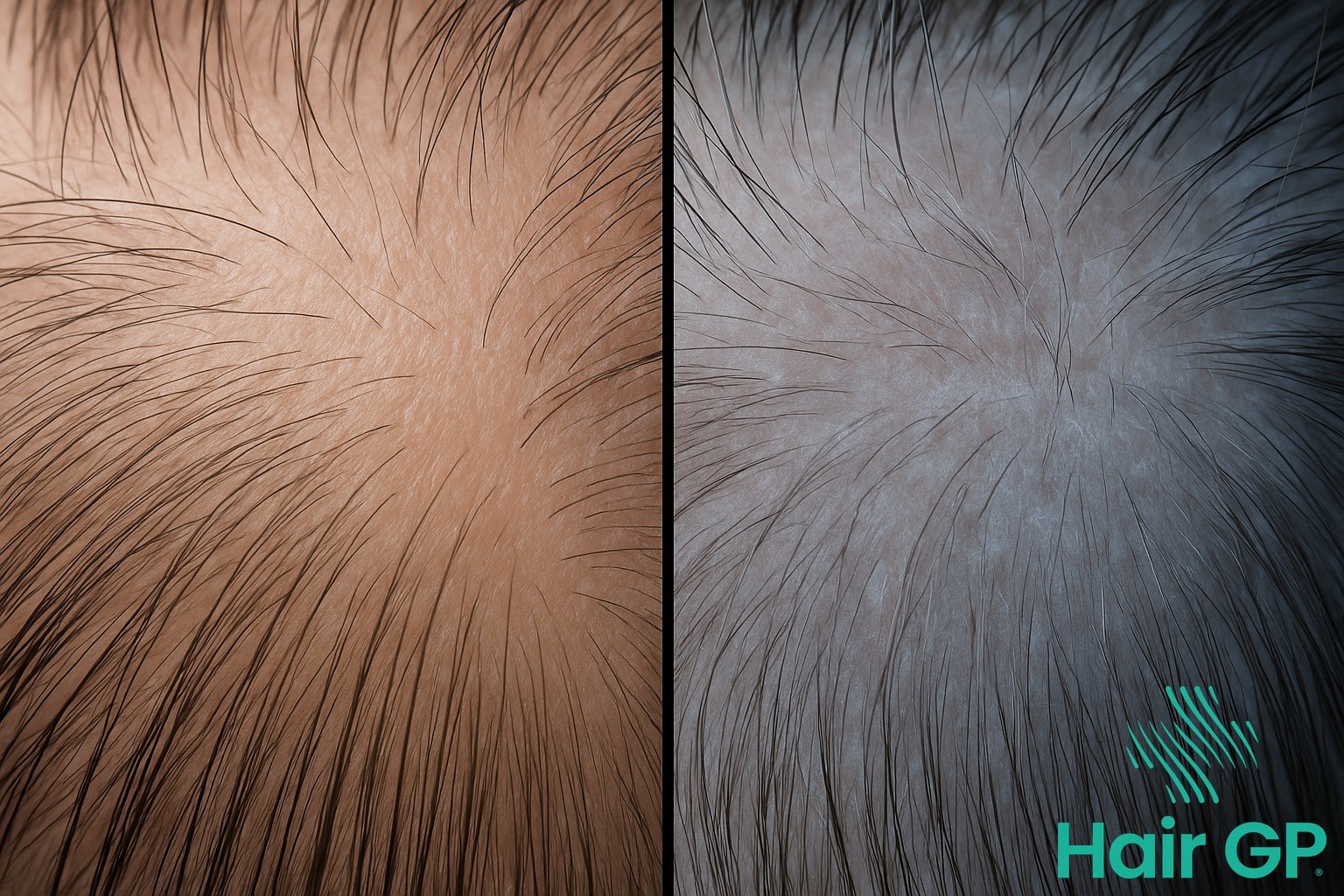
Blue Light vs Other Light Therapies
Phototherapy for scalp health encompasses various wavelengths, each offering distinct therapeutic benefits. Whilst blue light targets antimicrobial activity and sebum regulation, red light therapy operates through different biological pathways. Red light, typically between 630-700nm, penetrates deeper into scalp tissues and stimulates cellular energy production through mitochondrial activation. This fundamental difference makes red light particularly effective for hair growth stimulation and anti-inflammatory effects, complementing blue light’s surface-level antimicrobial action.
Low level light therapy (LLLT) combines multiple wavelengths to maximise therapeutic outcomes. Studies indicate that red light therapy shows superior results for androgenetic alopecia, with improvements in hair density ranging from 20-35% over treatment periods. Blue light excels in managing seborrhoeic dermatitis and acne-related scalp conditions due to its bactericidal properties. The choice between LED and lasers depends on treatment goals – light emitting diodes offer broader coverage and gentler treatment suitable for home use, whilst laser devices provide more focused energy delivery for clinical applications.
Near infrared wavelengths (700-1000nm) penetrate even deeper than visible light, reaching follicular stem cells and improving blood circulation. This deeper penetration makes near-infrared particularly valuable for addressing inflammatory scalp conditions and supporting tissue repair. Some advanced devices combine blue, red, and near-infrared wavelengths to address multiple scalp concerns simultaneously.
Selecting the appropriate light therapy depends on the primary scalp condition. For oily scalps with bacterial concerns, blue light remains the optimal choice. Hair loss responds better to red light or combination therapies incorporating near-infrared. Inflammatory conditions often benefit from red and near-infrared wavelengths due to their anti-inflammatory effects. Many practitioners recommend combination approaches, using blue light for immediate antimicrobial effects whilst incorporating red light therapy for long-term scalp health improvement and hair growth stimulation.
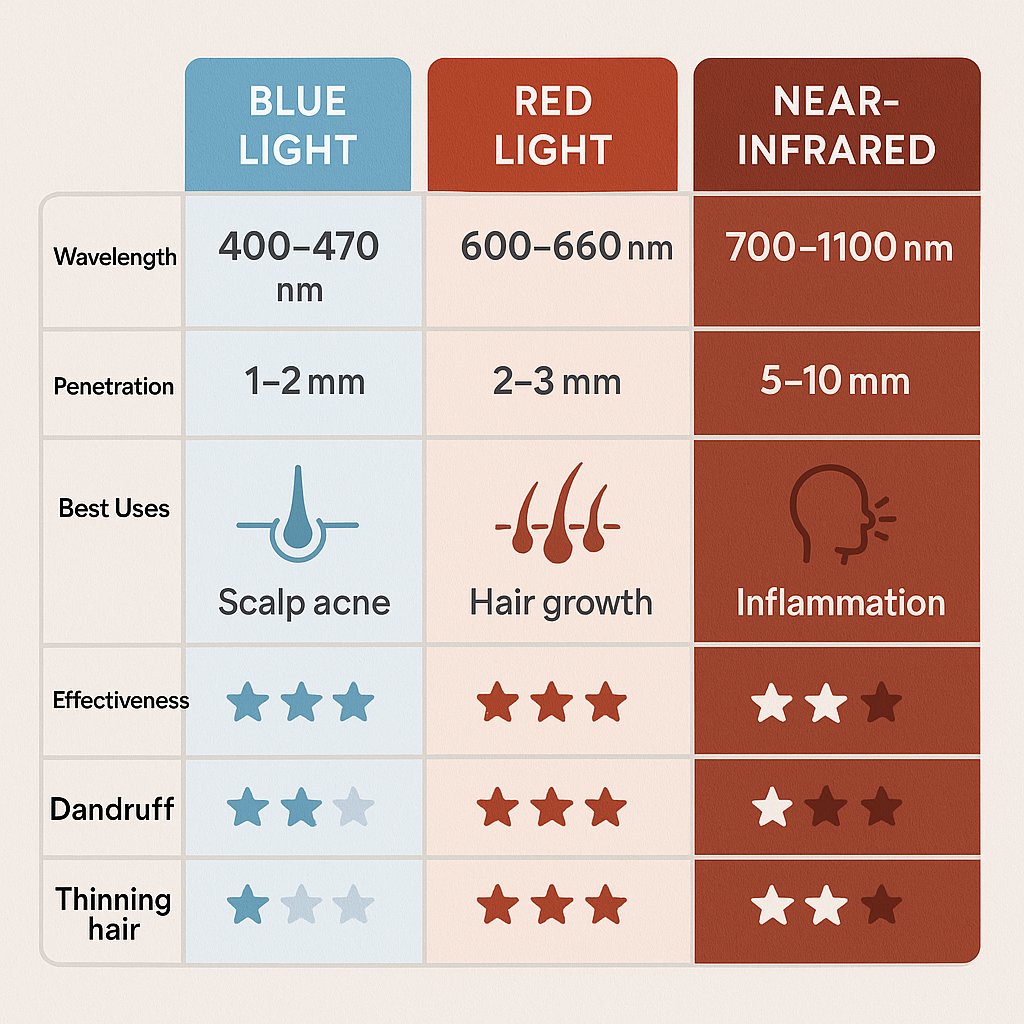
Practical Applications and Devices
The accessibility of blue light therapy has expanded significantly with the development of various treatment devices designed for both home and clinical use. These innovative solutions offer targeted approaches to addressing scalp problems whilst providing flexibility in treatment schedules and settings. Understanding the available options helps individuals select the most appropriate method for their specific hair care needs.
Home Treatment Options
Consumer-friendly LED devices have revolutionised at-home scalp treatment, offering convenient solutions for regular therapy sessions. Handheld light therapy combs and caps represent popular choices, typically featuring wavelengths between 415-470nm specifically calibrated for scalp applications. These treatment devices generally require sessions of 10-15 minutes, performed 3-4 times weekly for optimal results.
Most home devices utilise low-level illumination protocols, ensuring safety whilst maintaining therapeutic efficacy. Users typically observe initial improvements in scalp condition within 4-6 weeks, with more substantial changes becoming apparent after 12-16 weeks of consistent use. The convenience of home treatment allows for easy integration into existing hair care routines, though patience and consistency remain essential for achieving desired outcomes.
Professional Treatment Protocols
Clinical settings offer advanced LED therapy systems with higher power outputs and precisely controlled wavelengths, enabling dermatologists to customise treatments for specific scalp conditions. Professional protocols typically involve initial intensive phases with twice-weekly sessions for 4-6 weeks, followed by maintenance treatments every 2-4 weeks.
Combination therapies represent a significant advantage of professional treatment, where blue light therapy integrates with topical medications, red light therapy, or microneedling procedures. This multi-modal approach often accelerates results and enhances overall treatment efficacy. Scalp specialists monitor progress through scalp photography and trichoscopy, adjusting protocols based on individual response patterns.
Cost considerations vary significantly between home and professional options, with consumer devices ranging from £100-500 for quality units, whilst clinical sessions typically cost £50-150 per treatment. Many practitioners recommend beginning with professional assessment before investing in home devices, ensuring appropriate treatment selection for specific scalp problems.

Best Practices for Safe Use
Implementing proper safety protocols ensures effective blue light therapy whilst protecting your wellbeing. The most crucial protective measure involves shielding your eyes during treatment sessions, as direct light exposure can potentially cause retinal damage. Always use appropriate eye protection, such as specialised goggles or blackout eye masks designed for light therapy. Position devices carefully to avoid direct eye contact, maintaining the recommended distance from your scalp as specified by the manufacturer.
Treatment timing plays a vital role in maximising benefits whilst minimising risks. Begin with shorter sessions of 10-15 minutes, gradually increasing duration as your scalp adapts. Most practitioners recommend limiting sessions to 20-30 minutes maximum, performed 2-3 times weekly. Schedule treatments at consistent times to establish a sustainable hair care routine, preferably when you can remain still and relaxed.
Before incorporating blue light therapy, remove any photosensitising products from your scalp and ensure the treatment area is clean and dry. Discontinue use if you experience unusual warmth, tingling, or discomfort. Individuals taking photosensitising medications or with light-sensitive conditions should consult healthcare providers before beginning treatment. By following these guidelines, you can safely harness blue light’s benefits for optimal scalp health.
Conclusion
The relationship between blue light and scalp health presents a nuanced paradox requiring careful consideration. Whilst light therapy demonstrates therapeutic potential for specific conditions, excessive exposure poses risks to overall hair health. Research confirms blue light’s antimicrobial properties and sebum regulation benefits, yet evidence equally highlights concerns regarding oxidative stress and follicle damage.
Adopting a balanced approach remains crucial for optimal outcomes. Protective measures during screen time, combined with controlled therapeutic applications when medically indicated, offer the most sensible strategy. Individual susceptibility varies considerably, necessitating personalised assessment of exposure patterns and scalp conditions.
Future research must address long-term effects, optimal dosing protocols, and protective mechanisms. Until comprehensive studies provide clearer guidelines, individuals should monitor their blue light exposure thoughtfully, particularly evening screen use that disrupts circadian rhythms.
Making informed decisions about blue light exposure empowers individuals to protect their scalp health whilst potentially benefiting from therapeutic applications when appropriate.
Frequently Asked Questions
While the blue light from digital devices is less intense than therapeutic devices, prolonged exposure may contribute to oxidative stress in skin cells. However, the scalp is typically protected by hair, and current research hasn’t definitively linked screen exposure to scalp damage. Focus on overall screen time reduction for general health benefits.
Results vary depending on the condition being treated. For dandruff and mild scalp inflammation, improvements may be seen within 2-4 weeks of regular treatment. Psoriasis and more chronic conditions typically require 8-12 weeks of consistent therapy. Hair growth benefits, if any, usually take 3-6 months to become noticeable.
Blue light therapy is generally safe for all hair types and colors since it primarily affects the scalp rather than the hair shaft. However, individuals with very light or albino skin may be more sensitive and should start with shorter exposure times. Always consult a dermatologist if you have specific concerns.
Yes, blue light therapy can often be combined with other treatments like minoxidil, finasteride, or red light therapy. However, avoid using photosensitizing medications or products immediately before blue light exposure. Always inform your healthcare provider about all treatments you’re using.
Blue light (450-495nm) is part of the visible light spectrum and doesn’t contain harmful UV radiation. UV light treatments use ultraviolet wavelengths that can damage DNA and increase cancer risk with overexposure. Blue light therapy is generally considered safer but should still be used according to guidelines.
References
- Ouyang X, Yang J, Hong Z, et al. Mechanisms of blue light-induced eye hazard and protective measures: a review. Biomed Pharmacother. 2020;130:110577.
- Sliney DH. What is light? The visible spectrum and beyond. Eye (Lond). 2016;30(2):222-229.
- de Freitas LF, Hamblin MR. Proposed Mechanisms of Photobiomodulation or Low-Level Light Therapy. IEEE J Sel Top Quantum Electron. 2016;22(3):7000417.
- Nakashima Y, Ohta S, Wolf AM. Blue light-induced oxidative stress in live skin. Free Radic Biol Med. 2017;108:300-310.
- Cho S, Lee MJ, Kim MS, et al. Effects of infrared and blue light on hair growth cycle and oxidative stress in human dermal papilla cells. J Cosmet Dermatol. 2022;21(10):4493-4502.
- Patra V, Gallais Sérézal I, Wolf P. Potential of Skin Microbiome, Pro- and/or Pre-Biotics to Affect Local Cutaneous Responses to UV Exposure. Nutrients. 2020;12(6):1795.
- Pfaff S, Liebmann J, Born M, Merk HF, von Felbert V. Prospective Randomized Long-Term Study on the Efficacy and Safety of UV-Free Blue Light for Treating Mild Psoriasis Vulgaris. Dermatology. 2015;231(1):24-34.
- Marasca C, Tranchini P, Marino V, et al. The pharmacology of antibiotic therapy in the management of acne vulgaris. Expert Opin Pharmacother. 2018;19(14):1581-1589.
- Morton CA, Szeimies RM, Basset-Séguin N, et al. European Dermatology Forum guidelines on topical photodynamic therapy 2019 Part 1: treatment delivery and established indications – actinic keratoses, Bowen’s disease and basal cell carcinomas. J Eur Acad Dermatol Venereol. 2019;33(12):2225-2238.
- Avci P, Gupta A, Sadasivam M, et al. Low-level laser (light) therapy (LLLT) in skin: stimulating, healing, restoring. Semin Cutan Med Surg. 2013;32(1):41-52.
- Lanzafame RJ, Blanche RR, Bodian AB, et al. The growth of human scalp hair mediated by visible red light laser and LED sources in males. Lasers Surg Med. 2013;45(8):487-495.
- Hamblin MR. Photobiomodulation for the management of alopecia: mechanisms of action, patient selection and perspectives. Clin Cosmet Investig Dermatol. 2019;12:669-678.
- Pillai JK, Mysore V. Role of Low-Level Light Therapy (LLLT) in Androgenetic Alopecia. J Cutan Aesthet Surg. 2021;14(4):385-391.
- Nakashima Y, Ohta S, Wolf AM. Blue light-induced oxidative stress in live skin. Free Radic Biol Med. 2017;108:300-310.
- Liebel F, Kaur S, Ruvolo E, et al. Irradiation of skin with visible light induces reactive oxygen species and matrix-degrading enzymes. J Invest Dermatol. 2012;132(7):1901-1907.

